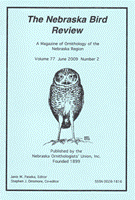Nebraska Ornithologists' Union

Nebraska Bird Review
Date of this Version
9-2015
Document Type
Article
Citation
Silcock, "Summer Field Report, June–July 2015," from Nebraska Bird Review (September 2015) 83(3).
Abstract
This summer was very wet over most of the state. Breeding Bird Survey operators noted impassible roads, especially in the western Sandhills. The benefits to water birds in the Rainwater Basin were obvious, however, with notable breeding records for Ruddy Duck and White-faced Ibis, as well as the first documented breeding in the state of Glossy Ibis, and the first Rainwater Basin breeding for Double-crested Cormorant and third for Eared Grebe.
Additional notable breeding records were led by Osprey; after 7 years of trying at various locations, success came with a bang, as at least 3 nests successfully fledged young, the first successful breedings for the state. A Barn Owl nest with 7 young was the first known in the extreme northeast, and a flightless juvenile Red-breasted Nuthatch in Seward provided an unexpected breeding record away from the north and west. Two developing situations suggest incipient breeding: there may now be two pairs of American Three-toed Woodpeckers in East Ash Canyon, Dawes County, and a major influx of Ovenbirds into Nebraska National Forest at Halsey the last two years suggests the first breeding there.
Several species of shorebirds arrived early, close to expected first dates, but both dowitchers really beat the early dates: a Long-billed was record early, and Shortbilleds were unusually early as well. A netted and banded Tennessee Warbler was record early by 16 days.
Rarities were few and not as mega as Summer 2014; a Snowy Plover was the first July record for the Rainwater Basin, 2 female Broad-tailed Hummingbirds (photographed together) were the 4th and 5th in spring for the state, and a vociferous Hooded Warbler set up shop at Nebraska National Forest at Halsey.
Notable was excellent coverage of the Niobrara River Valley from Valentine to the Niobrara Valley Preserve and grasslands southwest of Nebraska National Forest at McKelvie. Many out-of-state birders working those areas as well as the rest of the state reported their Nebraska sightings to eBird, providing useful information. One problem crops up in these situations though: non-local birders rarely have as good a grasp of species distribution within Nebraska as experienced locals, as exemplified by the several reports this summer of Brewer's Blackbirds in central and eastern Nebraska. As eBird filters continue to improve, such observations are expected to decline.


Comments
Copyright 2015 Nebraska Ornithologists’ Union. Used by permission.